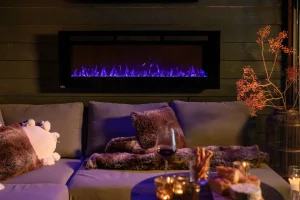While browsing through our brand descriptions, looking at fireplaces, or reading one of our blogs, you may come across an unfamiliar term. To help you, we’ve created a glossary of the most common words used for describing fireplaces and stoves. Peruse the list below to find fireplace terminology explained.
Bellows: A standard accessory for wood fireplaces that help combustion of the logs. They feed air to the fire with an expandable bladder to effectively fan the flames. They have no use for a gas fireplace but are sometimes used as a decoration.
BTU (British Thermal Unit): The main unit for heat measurement for fireplaces throughout North America. 1 BTU is the amount of energy needed to raise 1 lb of water by 1 Fahrenheit. Sometimes listed as kBTU to indicate a 1000 BTUs, e.g. 65 kBTU = 65 000 BTU.
Creosote: Condensed chemical deposits of distilled tar from burning wood. It builds up as loose deposits that congeal and harden over time in the chimney and flue. It is a toxic substance and a fire hazard, which is why your chimney should be cleaned regularly.
Damper: A flap or trap door that closes and opens through a lever on the fireplace to control air flow from the chimney to the fire. Sometimes installed in the chimney, it is now most often installed on the flue just above the fire box.
Fire bed: The bottom platform of bars or a grate the burning wood, coals, or coke rest on.
Firebox or Chamber: The inner chamber of the fireplace that contains the fire.
Flue: The pipe, duct, or opening in the firebox that feeds the fireplace or stove exhaust into the chimney. Are designed to minimize heat loss while allowing noxious gas to escape.
Hearth: Specifically refers to the slab at the base of the fireplace, typically a slab of hard stone or tiled concrete. Originally developed to protect a wooden floor from any damage and reduce the risk of spreading fire.
Insert: A fireplace that is inserted into the site of an old, existing fireplace. Allows switching to a different fuel type or more efficient fireplace.
LPG (Liquified Petroleum Gas): A petroleum gas liquified and contained in small and large cylinders. Often sold under the names of “Propane” and “Butane”. LPG is most commonly used to fuel fireplaces, stoves, and BBQs in homes that lack a natural gas line.
Gas: The most common type of fireplace and stove fuel alongside wood. They use either LPG (often Propane) or Natural Gas to sustain a continuous fire that can be controlled directly by controlling the gas supply. They must be sealed and cannot be opened to keep gas contained in the fireplace’s closed system.
Mantel: The entire ornamental facing surrounding the fire. Often the term is used to refer specifically to the mantel shelf above the fireplace.
Natural Gas: A colourless, odourless, and clean-burning fuel that is mostly methane. It is used in gas fireplaces of homes that have a gas line installed. Natural gas is also used in homes for gas stoves, ovens, and heating.
Non-Combustible: describes materials which do not ignite when exposed to fire. Every fireplace manufacturer sets a non-combustible clearance within which there shouldn’t be any combustible materials. We can help you pick the right product to meet your design and installation needs.
Propane: A proprietary name for liquid petroleum gas (see LPG). Often used to fuel gas fireplaces. It is a colourless, odourless, and non-toxic gas.
Stove: In heating, refers to a freestanding fireplace not mounted into the wall, instead of a kitchen’s cooking range. Can be both wood and gas burning.
TSSA Certified: The Technical Standards and Safety Authority is a public safety authority that operates on behalf of the Ontario government to ensure public safety in fueling and the handling of gasses for fireplaces and BBQs. Classic Fireplace and BBQ and our staff are proud of our TSSA certification
WETT Certified: The Wood Energy Technology Transfer Inc.is a non-profit organization that professionally trains for safe installation and maintenance of wood-energy products, such as fireplaces. Certification indicates that someone or a company abides by a code of ethics and public safety standards. Classic Fireplace and BBQ follows the standards established by WETT diligently.
Zero-Clearance: A gas fireplace specifically manufactured with high-performing insulation that can be safely inserted into and placed near combustible materials or surfaces like wood or paneling. It is named for the zero distance needed from these materials.












